Microsoft Ads vs Google Ads: Analyzing 10 Aspects Of Each Platform
- PPC: Paid Advertising
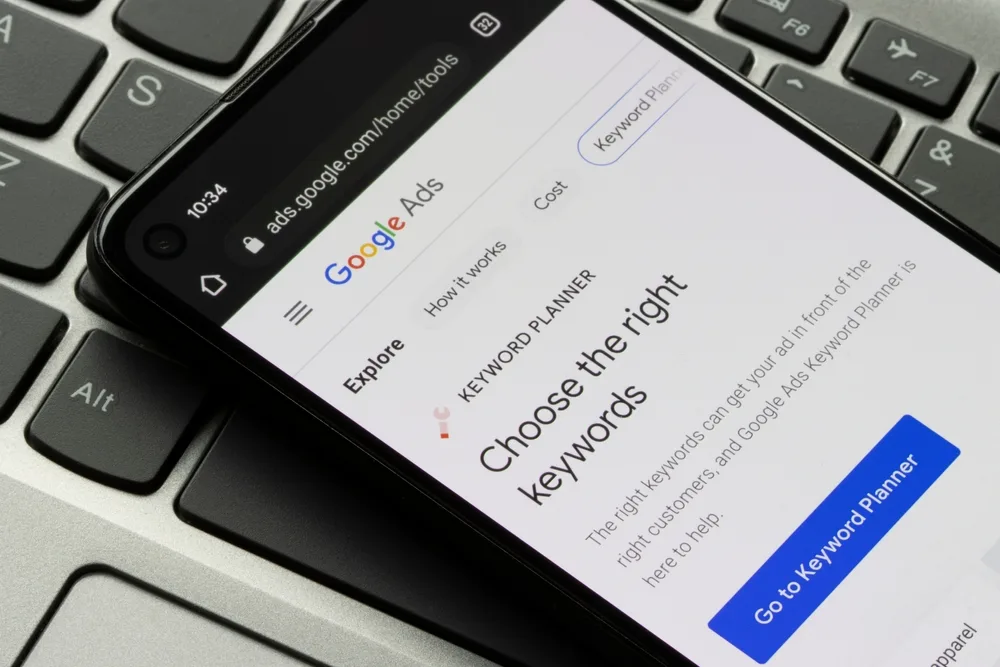
Creating pay-per-click (PPC) ads for your business is often one of the most powerful tools you have in the ever-changing landscape of digital marketing. But deciding on which platform to use to reach your ideal audience is often the first question you should ask if you are just starting off doing PPC.
Luckily in the United States, there are two primary PPC platforms to choose from that will help you reach your ideal users. These are Bing Ads and Google Ads. But deciding between Microsoft Ads vs Google Ads is a tougher question. Choosing the wrong platform for your business could mean wasting your budget, showing your ads to the wrong users, or jeopardizing your overall digital marketing strategy.
In this guide, we’ll cover the key differences and similarities between Microsoft Ads vs Google Ads.
Microsoft Ads vs Google Ads: 10 Key Differences and Similarities
While both platforms appear similar for the end product, Microsoft and Google Ads exhibit key differences and similarities. Understanding their relevance to your business will aid in deciding whether to use one platform or advertise on both simultaneously.
Platform Reach
It is a no-brainer that if you are only concerned about advertising on search engines such as Google or Bing, that reach is an important factor in deciding which platform to use.
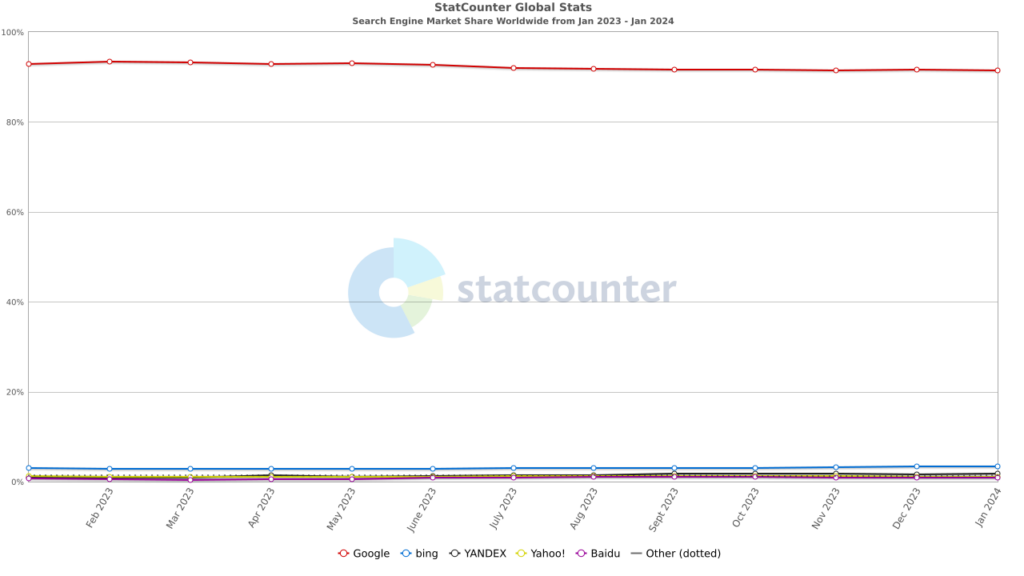
It is well-known that Google is the primary search engine used across the United States with a staggering 88% market share as of November 2023. Bing comes in second with almost 7% market share which is up 2% in the past five years due to added features such as ChatGPT integrated within the platform.
But the 7% that Microsoft Ads covers accounts for over 44 million searches that you aren’t reaching.
Another big factor to consider when talking about Microsoft Ads vs Google Ads is who you are trying to reach on the platforms.
Bing’s users are primarily older, are more likely to be married, more educated, and more affluent.
Google’s users are typically younger, work in white-collar roles, are more comfortable with technology, and grew up with Google as a standard of reference.
Additionally, Google has two ad networks on which your ads can show, the Google Search Network, which includes Google Play, Google Maps, Shopping, etc., and Google Display Network which consists of over 2 million sites. The Google networks are a large reason why advertisers often choose Google in the first place.
Microsoft Ads can be shown in a variety of different places on the Microsoft Advertising Network, These include search engines like Bing, AOL, Yahoo, and DuckDuckGo. Ads on Microsoft can also show up on MSN, Microsoft Edge, and Outlook apps.
Costs
After deciding where your users are likely searching, next look at the cost.
Since you will be paying per click on either platform, one of the most important differences is the average cost per click.
Google Ads often have 33% higher cost-per-clicks (CPC) on average than Microsoft Ads. This is because the competition level and bidding systems in which Google operates are much higher than on Bing.
One surprising fact is that retail advertisers often pay more for Microsoft Ads than Google Ads.

Audience Targeting
Both platforms offer excellent audience targeting options for all advertisers. However, when deciding between Microsoft Ads vs Google Ads for your business, it’s important to remember your audience targeting strategy. If you create a well-crafted ad but don’t show it to the right people at the right time, it will lead to wasted ad spend.
With Google Ads, you have two options for reaching your ideal audience. These are content and audience targeting.
With content targeting you can on the display networks where you want your ads to show or not show. This includes targeting topics, placements, or content keywords.
With Google Ads audience targeting you can target segments or groups of people with specific interests, intents, and demographic information.
Google Ads audience targeting is broken down into the following segment types:
- Affinity Segments
- Custom Segments
- Detailed Demographics
- Life Events
- In-Market
- Your Data Segments
Microsoft Ads offer a very similar targeting for your audiences with one distinct difference, LinkedIn Targeting.
With Microsoft Ads you can target and reach customers via:
- Custom Audiences
- Customer Match
- Device Targeting
- Dynamic Remarketing
- In-Market Audiences
- LinkedIn Targeting
- Location Targeting
- Remarketing
- Similar Audiences
Strategizing within audience segments can make or break your PPC advertising no matter which platform you use. Ultimately we think Google Ads audiences beat out Microsoft Ads due to the vast information available collected with Google’s sophisticated audience gathering.
Ad Formats
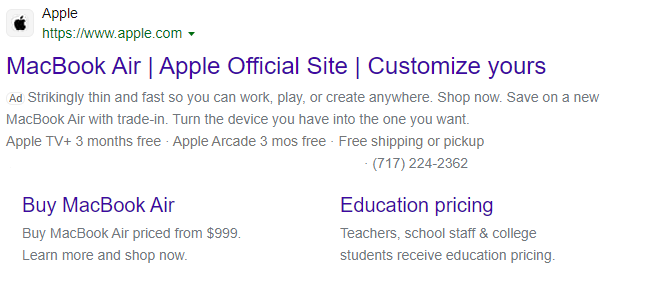
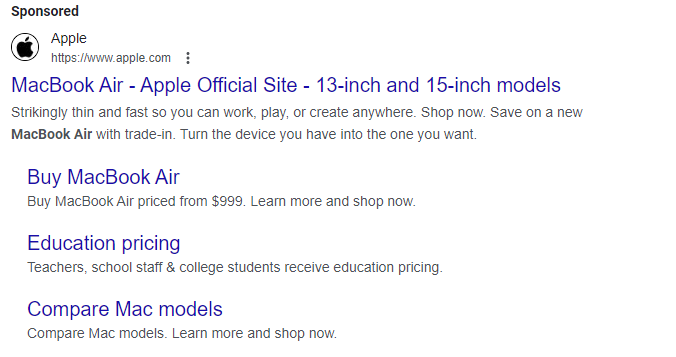
Deciding between Microsoft Ads vs Google Ads often depends on what you want to accomplish with the ads themselves. Both platforms offer a variety of different ad types to help you reach your customers where they are.
Both platforms offer:
- Responsive Search Ads
- Display & Native Ads
- Shopping Ads
- App Install Ads
- Video Ads
- Call-Only Ads
Most notably is the responsive search ads in both platforms. These are most likely the first ads you will create.
These operate in almost an identical fashion. In Google Ads or Microsoft Ads, you need to provide up to 15 headlines and four descriptions which the ad systems will mix and match the ideal combination of headlines and descriptions to match the user being targeted.
Both platforms are constantly updating ad format types to entice users to use their platforms.
Microsoft Ads has been expanding its platform with exclusive partnerships including Netflix Ads which makes them more competitive with Google Ads.
Google Ads has been adding new campaign types to combine the various ad formats including Demand Gen and Performance Max.
Keyword Match Types
No matter which platform you end up using, both offer keyword match types that are the same.
These Microsoft Ads vs Google Ads keyword match types are:
- Broad Match
- Phrase Match
- Exact Match
- Negative Keywords
Up until 2021, Google Ads utilized broad and phrase match modifiers but have been folded into the regular broad and phrase match types.
Click-Through Rates
Click-through rates (CTR) are often one of the first metrics to look at when analyzing your PPC ads as they give you a good idea of what is resonating with your audience.
While each of the ad formats mentioned above are in each platform, one in general has a much higher CTR than the other.
The average CTR on Google is 34% higher than on Microsoft Ads.
On average, Bing has a 2.83% CTR across all industries and Google Ads has a 3.17%.
In the Microsoft Ads vs Google Ads debate, if all factors are the same (meaning the headlines, and descriptions), the clear winner is Google Ads.
Conversion Rates
While CTR is an important metric to analyze in your PPC efforts, one that you need to pay the most attention to is conversion rate.
The Microsoft Ads conversion rate on average is 2.94% across all industries.
Google Ads conversion rate on average is 3.75% across all industries.
This means that if you have responsive search ads set up with conversions being the same across both platforms, on average Google Ads has a higher conversion rate by 81%.
Google Ads’ system for optimizing for conversions is unmatched by Microsoft Ads. When everything is set up properly in your account, the AI and machine learning capabilities of Google Ads is able to recognize which users are more likely to convert over the Microsoft Ads users.
UX Designs
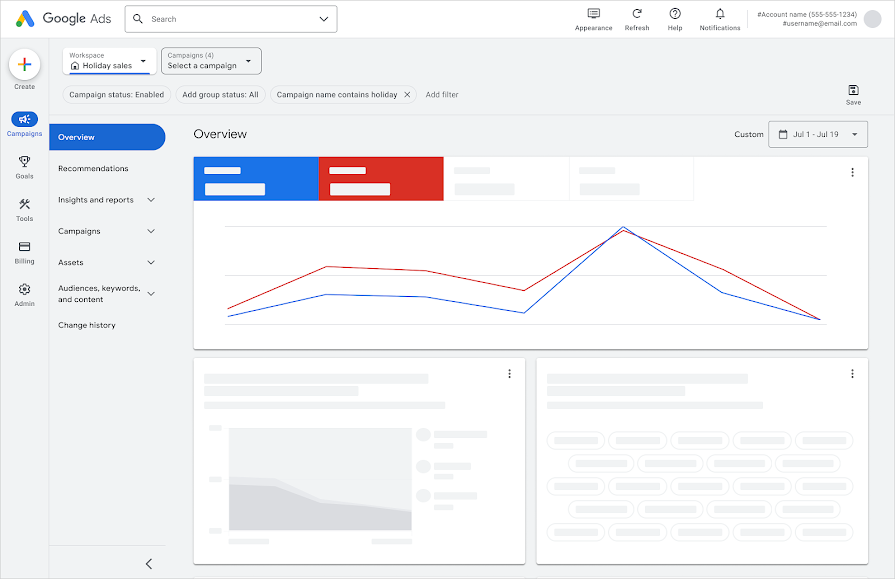
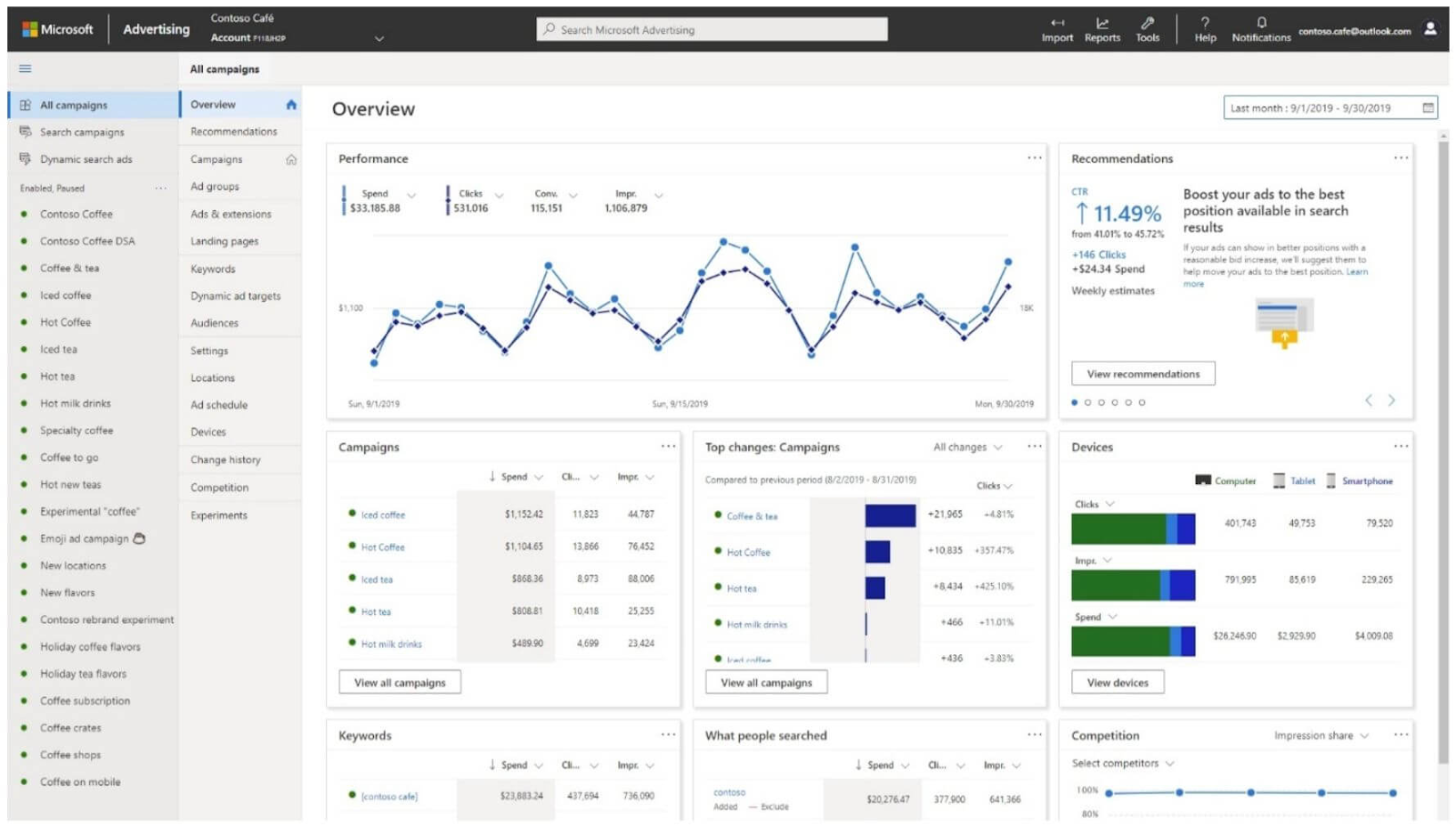
One of the more obvious aspects when deciding between Microsoft Ads vs Google Ads you will notice is the user experience behind each platform.
Microsoft Ads is built to mimic Google Ads and that is not by mistake.
Microsoft Advertising wants you to feel a very familiar sense when you enter the platform so you feel like you have a sense of congruency when using it. They believe that if users come to a new platform, and have to learn an entirely new system and account structure, they won’t use it.
In fact, when you create a Microsoft Ads account, you can import your Google Ads campaigns into the platform and have them be almost identical.
Free Tools & Resources
Having free tools and resources for your PPC campaign is game-changing if you do not pay for search engine marketing tools such as SEMrush or Ahrefs.
Both Microsoft Ads and Google Ads have tools to help you plan your keywords traffic and volume, shared libraries, bulk actions & apps, conversion tracking, and basic setup assistance.
Very similar to the UX design, Microsoft Ads is built to mimic the Google Ads tools and resources.
However, one of the key differences between Microsoft Ads vs Google Ads is the integration of Google platforms within the Google Ads system. Since Google Analytics is the primary and standard platform for marketers to use, they have made it very easy to connect Google Analytics to Google Ads.
The Microsoft Ads system for connecting your Google accounts is different than Google Ads.
Rather than simply importing your Google Analytics goals and conversions into Microsoft Ads, Microsoft Ads uses Universal Event Tracking (UET) tags to measure user events that happened from the Microsoft Ads system.
Luckily, if you are using Google Tag Manager for custom events, you can easily add in the UET tag and send over those custom events to Microsoft Ads.
Customer Service
One final note about Microsoft Ads vs Google Ads that we want to mention is the customer service element of each platform.
You never know when you will run into issues that you will need to contact the customer service from either platform.
In recent years, it has been increasingly difficult to get in contact with Google Ads. There used to be a live chat feature where you could contact someone from Google and get assistance right away but now there are only options for emailing someone, asking the community, or booking an appointment which costs $50 per call. Occasionally, you will get a request from a Google Ads specialist who will walk through your account with you but that is not the case with every account on Google.
Microsoft Ads has similar customer service help options but offers live chats or you can request a call from support. We like having live chat in Microsoft Ads.
Conclusion
The choice between Microsoft Ads vs Google Ads is a pivotal decision for businesses venturing into the realm of pay-per-click (PPC) advertising. Both platforms have their distinct advantages and cater to different demographics, making it crucial for advertisers to align their strategies with the characteristics of their target audience.
While Google Ads dominates the search engine market share, Microsoft Ads offers unique opportunities to tap into a substantial user base that may be overlooked. The differences in costs, audience targeting, ad formats, keyword match types, and user experience should all be carefully considered based on the specific goals and preferences of each business.
Ultimately, no matter which platform you choose to use, it should be worth noting that running ads on both Google Ads and Microsoft Ads is recommended. When you carefully create a PPC strategy using both, you will be able to compare which platform is best for you in the long run.
If you’re struggling on either of the platforms, Tower Marketing’s PPC management experts are equipped to help. Reach out to a team member to schedule a free PPC management consultation.
 By Trevor
By Trevor  Lauren
Lauren  Sierra
Sierra